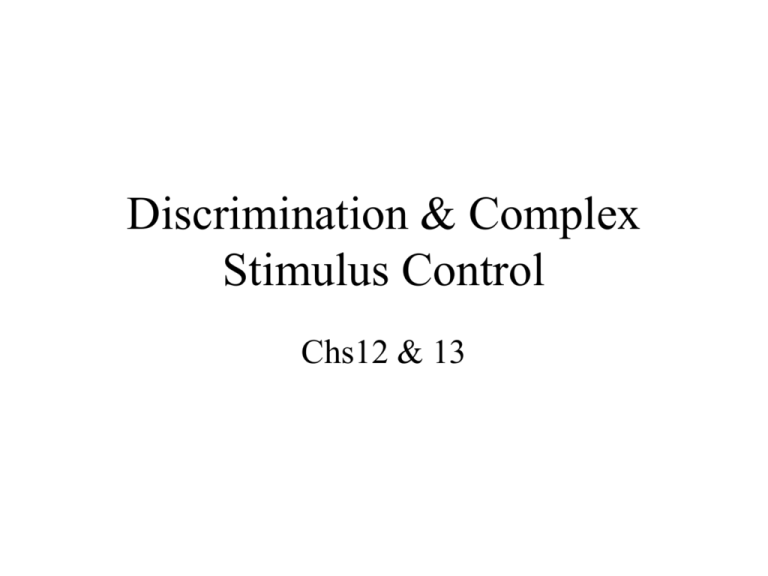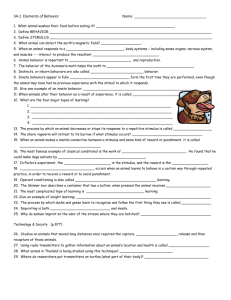Complex Discrimination & Imitation
advertisement

Discrimination & Complex Stimulus Control Chs12 & 13 Reinforcement-Based Discrimination SD Before After Behavior SD After Discriminative Stimulus D (S ) • A stimulus in the presence of which a particular response will be reinforced or punished S-delta D (S ) • A stimulus in the presence of which a particular response will not be reinforced or punished Reinforcement-Based Discrimination SD Brelandlesss target Before Chicken has no food After Chicken has food Behavior Chicken pulls the trigger After SD Breland Chicken has no food Discrimination Training Procedure • Reinforcing or punishing a response in the presence of one stimulus and extinguishing it or allowing it to recover in the presence of another stimulus. Stimulus discrimination (stimulus control) • The occurrence of a response more frequently in the presence of one stimulus than in the presence of another, usually as a result of a discrimination training procedure Differential Reinforcement vs. Stimulus Discrimination One Response Class Two Response Classes One Stimulus Two Stimuli No differentiation or discrimination Response differentiation Stimulus discrimination Combined differentiation & discrimination Concept training • Intuition? – Control by a concept or set of contingencies the person or organism does not define or describe • Concept of PERSON is complex Herrnstein & Loveland • Concept training procedure with nonverbal animal Concept Training SD Various pictures of people Before Behavior No grain Pigeon pecks key Sdelta Various pictures with no people After Pigeon has grain After Pigeon has no grain Concept Training SD Various Picasso paintings Before Behavior No grain Pigeon pecks key Sdelta Various painting by others After Pigeon has grain After Pigeon has no grain Complex Stimulus Control • Conceptual stimulus control Stimulus class (concept) • A set of stimuli all of which have some common physical property • A stimulus class is the same thing as a concept Stimulus generalization • The behavioral contingencies in the presence of one stimulus affects the frequency of the response in the presence of another stimulus • E.g. – reinforcement for pecking in presence of 1 Picasso painting affects likelihood of pecking in presence of another Picasso painting (more likely) Concept Training • Reinforcing or punishing a response in the the presence of one stimulus class and extinguishing it or allowing it to recover in the presence of another stimulus class Concept training Vs. Conceptual stimulus control Conceptual stimulus control • Responding occurs more often in the presence of one stimulus class and less often in the presence of another stimulus class because of concept training Testing for stimulus generalization • Test for stimulus generalization using novel stimuli • If respond correctly to novel stimuli, can say the behavior is under the stimulus control of concepts. Stimulus generalization vs. stimulus discrimination • Responds in presence of SD but not in the presence of SD. This is ______________ • Responds at similar rates in presence of SD and SD. This is __________________ Stimulus Generalization Number of Responses 60 50 40 30 20 10 0 red green blue yellow Stimulus Discrimination 45 Number of Responses 40 35 30 25 20 15 10 5 0 red green blue yellow Stimulus-Generalization Gradient Number of Key Pecks 350 300 250 200 150 100 50 0 Blue Yellowgreen TEST COLORS Red Generalization vs. Discrimination • Amount of generalization is the opposite of the amount of stimulus discrimination (stimulus control) Fading, Errorless Learning, Imitation Chapter 13 & 14, Part 2 Fading • Stimulus dimensions – The physical properties of stimuli Stimulus Dimensions • Stimuli differ from each other – House vs. car • Obvious dimensions – Size, weight, shape, material, etc. vs. Stimulus Dimensions • The more dimensions along which objects differ, the easier to establish a discriminative stimulus control • The fewer dimensions along which objects differ, the harder it is to establish discriminative stimulus control Example • • • • Good golf balls (SD) vs. bad golf balls (SD) This is a discrimination that is difficult How can the discrimination be established? The 2 golf balls are similar in so many dimensions….and differ in only a few – Roundness, resiliency, hardness of cover Make stimulus dimensions more salient, then use fading • • • • Color the bad golf ball green Leave the good golf ball alone Reinforce picking out good golf balls Don’t reinforcer picking bad (green) golf balls Fading • Gradually fade out the difference between good balls and bad balls by reducing the “green” Fading procedure • At first, the SD and the SD differ along at least two stimulus dimensions (green & white, new & old). • The difference between the SD and the SD along all but one dimension is reduced until there is no difference along the reduced dimensions. • The the SD and the SD differ along only one dimension Errorless Discrimination Procedure • The use of a fading procedure to establish a discrimination, with no errors during training. Jimmy Jimmy Susan Jimmy Susan Jimmy Susan Jimmy Susan Jimmy Susan Jimmy Susan Reinforcement-Based Discrimination SD Jimmy on a white black card Before Behavior Jimmy has no raisin Jimmy picks card SD Susan on a black card After Jimmy has a raisin After Jimmy has no raisin Stimulus Dimensions • Lettering • Shading • At first, choice of cards was under the control of the dimension of ________ • Then, after fading, responding was under the control of the dimension of _______ Techniques of Gradual Change Procedure Area of Application Purpose Shaping Response differentiation To bring about a response not made by the organism Reinforcer Reduction Type & amount of reinforcer To maintain responses already made or to establish a particular pattern of responses Fading Stimulus discrimination To bring the response under the control of stimuli that didn’t exert control initially Reinforcer Reduction • Move from primary to secondary reinforcers • Change from 3 pellets to 1 pellet Imitation • The form of the behavior of the imitator is controlled by similar behavior of the model Imitation Training: Stimulus Discrimination SD Raised arm and “do this” Before Behavior Marilla has no food & praise Marilla raises arm After Marilla has food & praise SD After No arm raised or no “do this” Marilla has no food & praise Imitation Training: Differential Reinforcement After Behavior Before Marilla has no food & praise Marilla raises arm Marilla has food & praise Behavior After Marilla raises arm Marilla has no food & praise Training Imitation • Train imitation with a partner – – – – Touch nose Touch toes Raise hand Etc…… Generalized Imitation • Imitation of the response of a model without previous reinforcement of imitation of that specific response.





